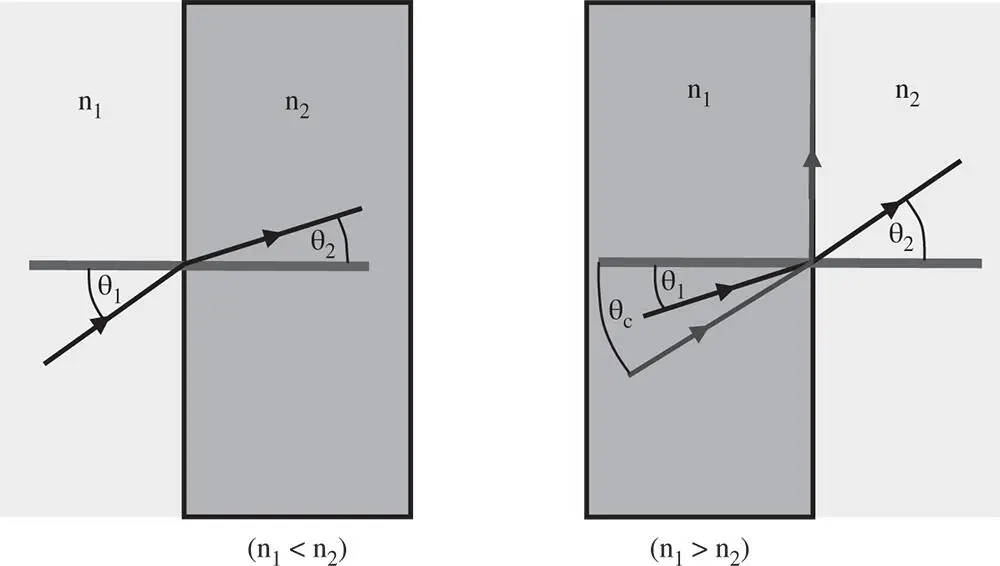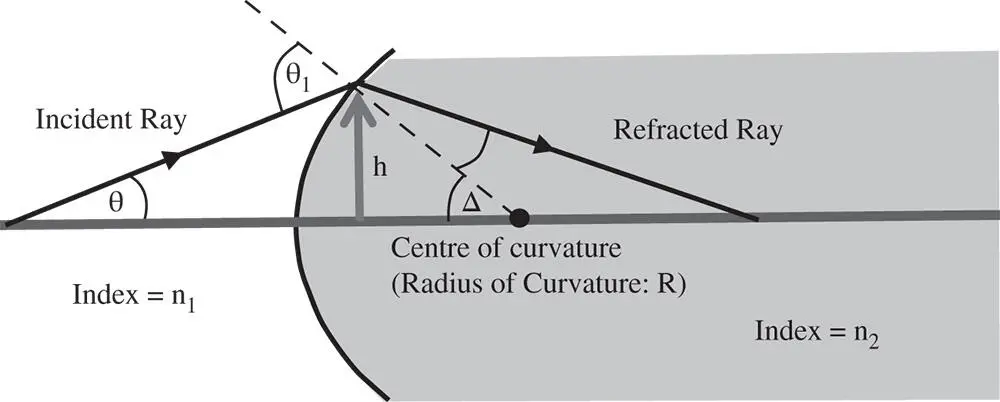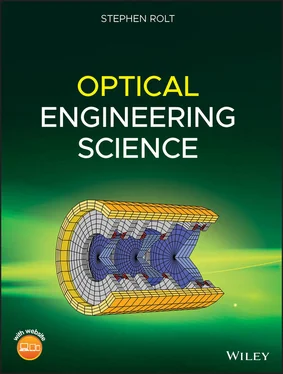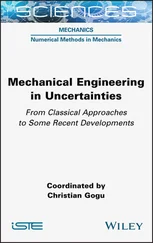1 ...8 9 10 12 13 14 ...50 Propagation through a homogeneous medium
Refraction at a planar surface
Refraction at a curved (spherical) surface
Refraction through lenses
Reflection at a planar surface
Reflection at a curved (spherical) surface
As previously set out, the path of rays through a system is governed entirely by Fermat's principle. From this point, we will apply the simplest definition of Fermat's principle and assume that the time or optical path of rays is minimised. As far as propagation through a homogeneous mediumis concerned, this leads to a perhaps obvious and trivial conclusion that light travels in straight lines. In fact, this describes a specific application of Fermat's principal, known as Hero's principle, namely that light follows the path of minimum distance between two points within a homogeneous medium.
1.4.2 Refraction at a Plane Surface and Snell's Law
The law governing refraction at a planar surface is universally attributed to Willebrord Snellius and referred to as Snell's law. This states that both incident and refracted rays lie in the same plane and their angles of incidence and refraction ( with respect to surface normal ) are given by:
(1.12) 
This is illustrated in Figure 1.12.
The refractive indices of some optical materials (at 550 nm) are listed below:
Glass (BK7): 1.52
Plastic (Acrylic): 1.48
Water: 1.33
Air: 1.00027
Snell's law is, in fact, a direct consequence of Fermat's principle. The reader may wish to derive this through the application of differential calculus. In finding the optimum path from a point in one medium to a point in another medium, the ray will attempt, as far as possible, to minimise its path through the higher index medium. Snell's law thus represents the minimum optical path condition in this instance. Where the ray passes from a high index material to a low index material, there exists an angle of incidence where the angle of refraction is 90°. This angle is known as the critical angleand, for angles of incidence beyond this, the ray is totally internally reflected. The critical angle, θ c, is given by:

Figure 1.12 Refraction at a plane surface.
(1.13) 
A single refractive surface is an example of an afocal system, where both focal lengths are infinite. Although it does not bring a parallel beam of light to a focus, it does form an image that is a geometrically true representation of the object.
1.4.3 Refraction at a Curved (Spherical) Surface
Most, if not all, curved optical surfaces are at least approximately spherical and are widely employed in the fabrication of lens components. Figure 1.13illustrates refraction at a spherical surface.
As before, the special case of refraction at a spherical surface may be described by Snell's law:

If we now wish to calculate the angle φ in terms of θ, this process is, in principle, straightforward. We need also to take into account the angle the surface normal makes with the optical axis, Δ, and the radius of curvature, R , of the spherical surface. However, calculation is a little unwieldy, so therefore we make the simplifying assumption that all angles are small and:

Figure 1.13 Refraction at a spherical surface.

Hence:

We can finally calculate φ in terms of θ:
(1.14) 
There are two terms on the RHS of Eq. (1.14). The first term, depending on the input angle θ is of the same form as Snell's law (for small angles) for a plane surface. The second term, which gives an angular deflection proportional to the height, h , and inversely proportional to the radius of curvature R , provides a focusing effect. That is to say, rays further from the optic axis are bent inward to a greater extent and have a tendency to converge on a common point. The sign convention used here assumes that positive height is vertically upward, as displayed in Figure 1.13and a positive spherical radius corresponds to a scenario in which the centre of the sphere lies to the right of the point where the surface intersects the optical axis. Finally, a positive angle is consistent with an increase in ray height as it propagates from left to right in (1.13).
Equation (1.14)can be used to trace any ray that is incident upon a spherical refractive surface. If this surface is deemed to comprise ‘the optical system’ in its entirety, then one can use Eq. (1.14)to calculate the location of all Cardinal Points, expressed as a displacement, z along the optical axis. Positive z is to the right and the origin lies at the intersection of the optical axis and the surface. The Cardinal points are listed below. Cardinal points for a spherical refractive surface
 |
 |
 |
 |
| Both Principal Points: z = 0 |
|
| Both Nodal Points: z = R |
|
In this instance, the two focal lengths, f 1and f 2are different since the object and image spaces are in different media. If we take the first focal length as the distance from the first focal point to the first principal point, then the first focal length is positive. Similarly, the second focal length, the distance from the second principal point to the second focal point, is also positive. The principal points are both located at the surface vertex and the nodal points at the centre of curvature of the sphere. It is important to note that, in this instance, the principal and nodal points do not coincide. Again, this is because the refractive indices of object and image space differ.
Читать дальше























